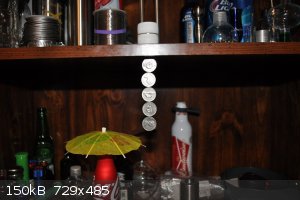Brain&Force
Hazard to Lanthanides
    
Posts: 1302
Registered: 13-11-2013
Location: UW-Madison
Member Is Offline
Mood: Incommensurately modulated
|
|
A better demonstration of the Curie temperature
I have some gadolinium metal (20 grams) and one of the demonstrations that is commonly done with the metal is its readily accessible Curie temperature
(around 20 degrees C). Below the temperature, the metal is ferromagnetic and can be easily lifted by a magnet. Above the temperature it is
paramagnetic and can be lifted by a magnet but not as easily.
This doesn't, however, demonstrate the difference between a ferromagnetic state and a paramagnetic one. I want to be able to do this. The ideal way is
to magnetize the chunk of gadolinium below its Curie temperature - this will show that a a ferromagnetic material can be magnetized but a paramagnetic
material can't.
I'll need a way to do this, however, that keeps the metal cold and makes it magnetic enough to lift at least a paperclip. Does anyone have
suggestions?
At the end of the day, simulating atoms doesn't beat working with the real things...
|
|
|
Sulaiman
International Hazard
    
Posts: 3696
Registered: 8-2-2015
Location: 3rd rock from the sun
Member Is Offline
|
|
In my local science museum (now closed) there was a simple demonstration of curie point that I remember from my early teens;
a thin metal disk (I had no idea what metal) about 100 mm diameter
with a bearing in the middle,
the disk had closely spaced holes of about 5mm diameter punched around the circumference, fairly close to the edge.
the disk was mounted in the vertical plane,
a horseshoe alnico magnet at 9 o'clock
a small gas flame could be moved to heat the edge of the disk at about eight o'clock.
the heat of the flame demagnetised the part of the disk in the flame
(the holes were to minimise heat spread I guess)
and the disk rotated anti-clockwise ... if my memory isn't corrupted.
|
|
|
Morgan
International Hazard
    
Posts: 1694
Registered: 28-12-2010
Member Is Offline
Mood: No Mood
|
|
I was toying with some Canadian nickels last year and found that if I slowly moved a chain of nickels several feet away from a neodymium magnet the
nickel would retain enough induced magnetism to hold/suspend the chain edge-to-edge if I didn't jiggle them too much. But once separated from each
other they lost their magnetism. This is a common effect but I suppose heating the nickels would soon bring about paramagnetism or a degradation of
the field, sort of as if they had been permanently magnetized and heated. I suspect pure nickel wouldn't make a good permanent magnet, even though it
is strongly attracted to a magnetic field.
I don't know how well gadolinium will hold a magnetic field on it's own or take to being a permanent magnet, but maybe you could try the nickel
experiment using gadolinium and a neomagnet to temporarily align the spin.
Here's a photo of some nickels being held by a 1 inch neo magnet in plastic bottle caps, separated by the shelf. I would grab the top nickel and
carefully move them away from the shelf. But only a few will hold, not all 5. (The bottle caps prevent accidental chipping from collisions.)

[Edited on 12-6-2015 by Morgan]
|
|
|
Sulaiman
International Hazard
    
Posts: 3696
Registered: 8-2-2015
Location: 3rd rock from the sun
Member Is Offline
|
|
I couldn't find a photo of the demo that I mentioned
but this is very similar http://eng-shady-mohsen.blogspot.co.uk/2011/01/new-curie-eff...
a variation http://drkfs.net/HEATENGINE.htm
and another https://www.youtube.com/watch?v=0detZxDJFbw
lots of them https://www.youtube.com/results?search_query=curie+motor
[Edited on 11-6-2015 by Sulaiman]
|
|
|